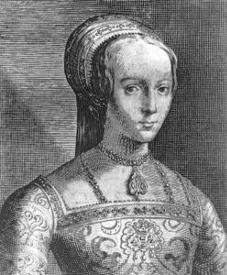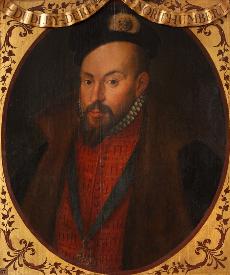Lady Jane Grey. Poor Lady Jane Grey. The pious and unsuspecting girl, shunted onto the English throne as a teenager, lasting only nine days before the formidable Mary Tudor deposed her and eventually ordered her execution. Used as a pawn in a game played by people far more powerful than her, she found herself placing her head on the executioner's block just as swiftly as she had placed the crown on it. Did she have any agency at all? Was she happy to accept the position that was thrust upon her? It is important to consider such questions in order to ensure she is remembered as something more than just a tragic footnote in history.
A short biography
Jane was born in October 1537, the daughter of Henry Grey, the Marquees of Dorset, and Lady Frances Baron. She was brought up in a firmly Protestant household and her commitment to her faith was intensified during her time in Henry VIII's royal court. Her father was an ambitious man whose constant political manoeuvring had earned him the title of Duke of Suffolk, and almost managed to have Jane marry Henry's son Edward, who was the same age as Jane and became Edward VI of England after Henry died in 1547. Instead, Jane married Lord Guildford Dudley, the son of the Duke of Northumberland, in 1553. Her marriage was the first of many strokes of misfortune for Jane that year.
A teenaged Jane Grey (image from Historic UK)
Why did she become Queen?
Her marriage to Dudley was unfortunate for her because her new father-in-law, the Duke of Northumberland, was an extremely pompous man who had become King Edward's closest advisor. This may not have been a problem in itself, but it became a big problem after Edward's sudden illness and death in the summer of 1553. As the young King lay on his deathbed the Protestant establishment fretted about who would succeed him: Edward had not had time to father any children, so the next in line to throne was his half-sister, Mary. This was a big problem, because Mary was Catholic.
Northumberland believed he had the perfect solution. Rather than letting a Catholic take the throne, why not bend the rules slightly to allow a Protestant to take over? Edward and Mary's other sibling, Elizabeth, was a Protestant, but could prove a bit too controversial. But what about young Jane Grey? She was Protestant, she was fifth in line to the throne (she was a great-granddaughter of Henry VII through her mother), and she just so happened to be Northumberland's daughter-in-law. What a happy coincidence.
It would not be happy for Jane (or indeed the Dudley family). Days before his death, Edward accepted Northumberland's suggestion and named her as his successor, and so it was that she was crowned Queen of England on 10th July 1553, four days after Edward's death.
Jane's father-in-law, the Duke of Northumberland, schemed to have her placed on the throne (image from wikipedia)
What did Jane think about all of this?
15-year-old Jane was initially reluctant to take the throne, but she did not have much choice. She may have been encouraged by the fact that the royal council affirmed her status as Queen, and she was almost certainly quietly confident about her abilities – she was fiercely intelligent, having been given a full classical education in her childhood, and she was famously charming and beautiful. Moreover, as a devout Protestant she doubtless felt duty-bound to do what she could to prevent a Catholic from becoming Queen. If it was God's plan that she must be the one to step in and prevent England from returning to the old faith, then who was she to question it? From her marriage to becoming Queen, it had all happened very quickly and she, like her husband and father-in-law, was in over her head. But once she was proclaimed Queen, she was determined to make herself a success. All she had to do was overcome the serious threat lurking outside London – Mary Tudor.
England's shortest reign
Things went very spectacularly wrong very quickly. The announcement to the public that Jane had been made Queen was met with outrage and it became clear that the people's loyalties were with Mary. Northumberland hastily put together an army and marched to meet Mary's army on 12th July, but his men steadily deserted him. On 19th July, the royal council rescinded their support for Jane and brought her nine days at the top to an end. The following day, Jane, Guildford Dudley, the Duke of Northumberland and the Duke of Suffolk, Jane's father, were all arrested and thrown in the Tower of London.
Northumberland was clearly the man who had orchestrated the plot, and he was beheaded without much controversy in August. However, Mary hesitated before deciding what to do with the other people involved. Jane's father was pardoned, but Jane and her husband were found guilty of treason and sentenced to death just after her 16th birthday. Still, there was a consensus that the young couple had not really been responsible for what had been Northumberland's scheme all along, and the death sentences were suspended for months. But Mary's hand was forced in early 1554 when another rebellion – supported by Jane's idiotic father – threatened her throne. She signed Jane and Dudley's death warrants at the beginning of February.
On the morning of 12th February 1554, Jane watched her husband being taken to his place of execution. A couple of hours later, it was her turn. As described by Ellen Castelow, she faced her death bravely, placing her own cloth over her eyes and feeling for the executioner's block. Her final words were a brief prayer, before the axe fell on her neck.
Jane Grey is rightly remembered as a tragic figure. At the age of 15, she was forced onto the throne by her scheming, overbearing father-in-law and proclaimed a traitor to her country. Her own father was no better to her, as it was his plotting that rid Queen Mary of any doubts she had about ordering Jane's execution. Yet to see her purely as a tragic figure is to rob her of her personality, to make a vivacious young woman merely an anonymous footnote. She could have made a decent fist of being Queen. But she was a child in an adult world, and fell victim to far more experienced players in the deadly game that was Tudor politics.
Cover Image - wikipedia


